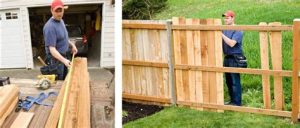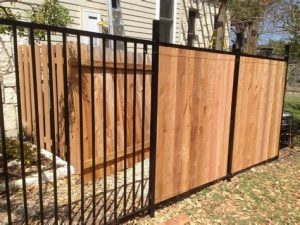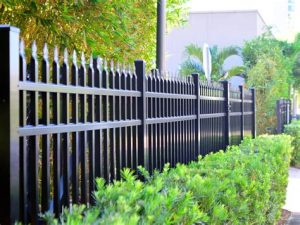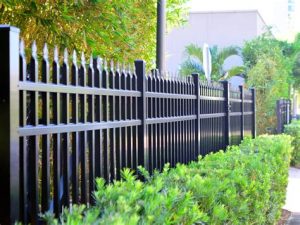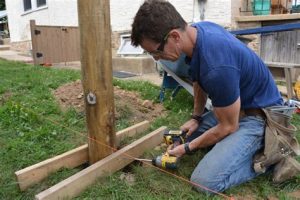Discover cost-saving strategies for DIY fence installation, increase property value, explore customization options, and enhance your curb appeal with the perfect fence.Installing your own fence can be a rewarding undertaking that offers numerous benefits beyond simply marking your property boundaries. For homeowners looking to save money, embarking on a DIY fence project can significantly cut costs compared to hiring professionals. But the advantages don’t stop there; tackling the installation yourself also allows for a deeper understanding of the process and greater pride in your accomplishment. Furthermore, a well-constructed fence can enhance your property value, providing both privacy and security. With the freedom to customize your design, materials, and color, you can create a fence that perfectly complements your home and reflects your personal style. Finally, a new fence can dramatically boost curb appeal, transforming your outdoor space into a welcoming haven. Join us as we explore the many benefits of installing your own fence, empowering you to take the leap into this fulfilling home improvement project.
Cost-saving
One of the most compelling reasons to consider a DIY fence installation is the significant cost savings that come with it. By choosing to install your own fence, you can avoid hefty labor costs typically charged by professional contractors, which can often account for 50% or more of the total project cost.
When you take on the fence installation yourself, you have control over the budget. You can shop around for materials and choose a fencing style that fits your financial situation. Moreover, many home improvement retailers offer seasonal sales or discounts, allowing you to further maximize your budget. Consider using recycled materials or opt for cost-effective options such as wood or chain link to further minimize expenses.
Another advantage of a DIY approach is that you won’t be rushed to complete the installation. You can work at your own pace, purchasing materials as your budget allows, which may make it easier to manage your finances. This flexibility often leads to a more enjoyable experience, and as a result, you’ll develop new DIY skills that can benefit future home improvement projects!
DIY fence installation process
Installing a fence by yourself can be an incredibly rewarding experience, both in terms of personal satisfaction and cost savings. The DIY fence installation process allows homeowners to tailor their project to their specific needs and preferences, while also learning valuable skills along the way. Here’s a step-by-step guide on how to successfully install your own fence.
1. Planning and Designing: Begin by sketching out your desired fence layout. Consider the purpose of the fence—whether it’s for privacy, security, or aesthetics. Check any local building codes or homeowners association guidelines that may dictate fence height, materials, or placement. It’s also essential to identify where your property lines are to avoid disputes with neighbors.
2. Materials and Tools: Once the design is finalized, gather the necessary materials. Common materials include wooden panels, vinyl, or chain-link. You will also need tools like a post hole digger, level, measuring tape, and hammer.
| Material | Description | Quantity Needed |
|---|---|---|
| Fence Panels | Sections that make up the fence | Based on yard dimensions |
| Fence Posts | Vertical supports for the panels | One every 6-8 feet |
| Concrete Mix | For securing posts in the ground | Estimated by post holes |
| Wood Sealer or Paint | For protection and customization | As needed |
3. Installation: Start by marking the location of each fence post using stakes or by marking the ground. Use a post hole digger to create holes at least 2 feet deep for stability. Place the posts in the holes, ensuring they are straight using a level, and fill with concrete mix for extra support. After the posts are securely set, attach the fence panels according to your design.
This DIY fence installation process presents an excellent opportunity for homeowners to exercise creativity and craftsmanship while enhancing their property.
Increased property value
One of the most significant advantages of installing your own fence is the potential for increased property value. Homebuyers often seek properties with well-defined boundaries and added privacy, making a fence an attractive feature. By taking on this project yourself, you not only save on labor costs but also make an investment that enhances your home’s overall worth.
According to recent studies, properties with well-maintained fences can see an increase in value ranging from 5% to 10%. This is especially true for homes in suburban neighborhoods, where a fence can offer security and a clear demarcation of one’s yard. This added curb appeal can draw in potential buyers and help your property stand out in a competitive market.
Furthermore, a fence can offer a sense of privacy and security that homebuyers prioritize. By choosing materials and styles that resonate with current trends, you can create an outdoor space that complements your home while increasing its resale value.
Customization options
When it comes to fence installation, one of the most significant advantages of taking the DIY route is the variety of customization options available. Whether you prefer a classic wooden fence, a modern vinyl option, or a sturdy metal barrier, the choices you make can fully reflect your personal style and the character of your property.
With DIY fence installation, you can select the height, material, and design of the fence that best suits your needs. For instance, if you live in a rural area, you might prefer a tall wooden fence that offers privacy and a rustic aesthetic, while urban homeowners might opt for sleek metal panels that complement a contemporary look. This ability to customize adds significant value to your property and makes your fence a true extension of your home.
Additionally, DIYers can incorporate decorative elements such as lattice tops, unique post caps, or even integrated lighting. These customization options not only enhance the fence’s appearance but can also improve functionality, creating a perfect balance between form and function that strictly adheres to your vision.
Enhanced curb appeal
One of the most significant advantages of installing your own fence is the enhanced curb appeal it brings to your property. A well-designed and constructed fence can elevate the visual aesthetics of your home, making it stand out in the neighborhood. This doesn’t just give a sense of pride to homeowners but can also positively influence the perceptions of potential buyers. When prospective buyers drive by and see a beautifully crafted fence, it can set a favorable tone even before they step inside the house.
Choosing the right style and materials for your fence can further enhance the curb appeal. Whether you opt for a classic white picket fence, a rustic wooden panel, or a contemporary metal design, the options are virtually endless. By selecting materials that complement the exterior of your home, you create a harmonious look that exudes character and charm. Furthermore, incorporating elements such as landscaping and decorative features can amplify this effect.
Moreover, a DIY fence installation allows you to customize every aspect of your project to meet your design preferences. By personalizing your fence, you can ensure that it aligns perfectly with the overall aesthetic of your property, thus maximizing its curb appeal.
Frequently Asked Questions
What are the primary benefits of installing your own fence?
Installing your own fence allows for greater customization, potential cost savings, and the satisfaction of completing a DIY project.
How can installing your own fence save money?
By doing the installation yourself, you can avoid labor costs associated with hiring professionals, which can significantly reduce the overall project cost.
What tools do I need to install a fence?
Basic tools required for fence installation include a post hole digger, level, tape measure, hammer, saw, and possibly a power drill.
Are there any specific regulations to consider before installing a fence?
Yes, it’s essential to check local zoning laws, building codes, and property lines to ensure compliance and avoid disputes with neighbors.
What types of materials are best for DIY fence installation?
Common materials include wood, vinyl, metal, and chain link. Each material has its pros and cons related to durability, cost, and maintenance.
How long does it typically take to install a fence on your own?
The duration can vary based on the size of the fence and the type of material used, but a typical DIY project may take anywhere from one day to a week.
What are some tips for ensuring a successful fence installation?
Plan your layout carefully, make sure to measure accurately, use quality materials, and seek advice or resources if you’re unsure about any steps.
